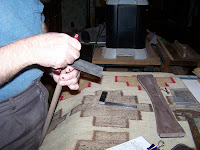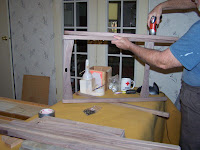Last night Marie and I came back here after supper. Marie was working on some decorative Christmas items to put in our gallery;
Treasures of Appalachia, and I worked on steamer trunk templates. While we have built and sold steamer trunks before, Brian was our trunk-meister but he has become very busy with his own woodworking and he still has the plans I gave him and the templates he made from those plans. Being a Rockler plan, there were errors in it that I hoped would have been corrected by now, so I bought a new set of plans and used them to produce the templates for the tricky shaped parts.

I was pleased to find that the plans now included full sized patterns for these parts and a large sheet of carbon/tracing paper to help make the process simple.

So I set about the task of tracing the shapes onto 1/8” birch plywood then cutting those shapes out on a band saw and shaping them to the line with a stationary belt sander then sanding all the faces and edges smooth and even.

Unfortunately, once they were done I discovered that the pattern for the lid center supports and the lid end pieces did not have the same shape. I did some investigating to see it was supposed to be that way, and no, it was not. In fact the patterns weren’t even the correct sizes; one is short by 1/16” in and the other is off by 1/8”. There were other problems as well, but you get the idea.
Sigh.

So I tossed the evenings work in the trash and started over taking my measurements from the dimensioned drawing in the plans. This took longer, but yielded useable templates.
We finally went home about 9:30 PM. Of course none of this time was billable because this is a "stock" item and we will be using these templates on other orders. This is one of those shop expenses that we just absorb.
This morning I got started working on the steamer trunks themselves. We are building four at one time: two in red oak (one stained black, one natural), 1 in maple (to be stained classic cherry) and one in walnut. Why 4? We have an order from a furniture store in Chicago for the two stained ones, but they expect a discount and the only way to get enough of a cost savings to offer them a discount is to build them in multiples of four or 5 at a time. The other two will be given a natural finish and posted to our web site as On-Hand items… Christmas is just around the corner!

Today I’ll be making the corner posts of the trunk body. These involve a splined miter joint where the two parts of the post meet and some joinery where other parts will tie into the corners. But I start by milling out a stack of blanks from 10 foot long rough planks of lumber; cut them to rough length, plane them smooth and rip them to width. Both parts of each post will be cut from one blank so the grain and coloring will match well.

I cut the miters with the “face” side of the blanks down on the table so the least amount of wood will be cut away on the good side, that will help the grain flow around the corners. But first, I mark each blank so I will be able to keep them paired up even if the stack topples over or something.

After cutting the miters, I flip the blanks over and cut the spline slots in the face of the miters. And finally I set the blade back to 90 degrees and trim each corner piece to the proper width. The cut-offs are made into the splines that lock the joint together.

Next we need to route a stopped groove in the edge of each of the 32 corner post pieces. This groove will house the side panels and tenons on the side rails. Because it does not go all the way to the top, I set up the router table with lines drawn on tape corresponding to the edges of the router bit. Then when my lay-out line on the piece being routed gets to the line on the near side of the bit, I stop and carefully lift the piece up and off of the bit.

The final task for today is to install the dado head on the table saw and cut a dado in each post part that will line up with matching grooves in the bottom rail to house the chest’s bottom plate. The plan calls for ½ inch plywood, but we avoid plywood when we can so we’ll make the bottom of solid wood and get tricky with the joinery so it can expand and contract without affecting the trunk.
That used up the whole day. Time to clean up and head home for supper.
Doug
 I started the morning off by pulling the clamps off of the honey locust that Marie and I prepped and glued up last night, then ran it through the surface planer to smooth it out and bring it down to the proper thickness.
I started the morning off by pulling the clamps off of the honey locust that Marie and I prepped and glued up last night, then ran it through the surface planer to smooth it out and bring it down to the proper thickness. Then it was back to the steamer trunks. Today I will be milling out stock for the filler panels that fit into the rails that frame the trunk. I do this by re-sawing thick lumber with the band saw to make thin lumber. In the oak and walnut I have stock wide enough to get the panels out of single boards, the maple however is all too narrow for this, so I’ll need to joint two pieces together.
Then it was back to the steamer trunks. Today I will be milling out stock for the filler panels that fit into the rails that frame the trunk. I do this by re-sawing thick lumber with the band saw to make thin lumber. In the oak and walnut I have stock wide enough to get the panels out of single boards, the maple however is all too narrow for this, so I’ll need to joint two pieces together.  The best way to do this is to resaw each thick, narrow board, open it up like a book and joint the inner edges to glue them back together into a wide, thin board. Doing this produces a good match in colors and some very pretty grain patterns. Much better than joining two separate boards then resawing that into thin boards.
The best way to do this is to resaw each thick, narrow board, open it up like a book and joint the inner edges to glue them back together into a wide, thin board. Doing this produces a good match in colors and some very pretty grain patterns. Much better than joining two separate boards then resawing that into thin boards. I do my jointing on the table saw with a very fine toothed saw blade. I’d rather use a jointer, but we don’t have one (yet) so I do it this way. Takes a little longer but gives good results if the saw is set up right.
I do my jointing on the table saw with a very fine toothed saw blade. I’d rather use a jointer, but we don’t have one (yet) so I do it this way. Takes a little longer but gives good results if the saw is set up right.  Then the thin pairs are taken into the assembly room to be glued and clamped. I clamp up as many pairs as I have clamps to do, then go back to resawing the walnut and oak. When the glue is set up enough, I pull the clamps and glue up another set. I won’t start surfacing them until all the blanks are glued up and I can do the whole set in one session, preferably with a helper.
Then the thin pairs are taken into the assembly room to be glued and clamped. I clamp up as many pairs as I have clamps to do, then go back to resawing the walnut and oak. When the glue is set up enough, I pull the clamps and glue up another set. I won’t start surfacing them until all the blanks are glued up and I can do the whole set in one session, preferably with a helper.














































